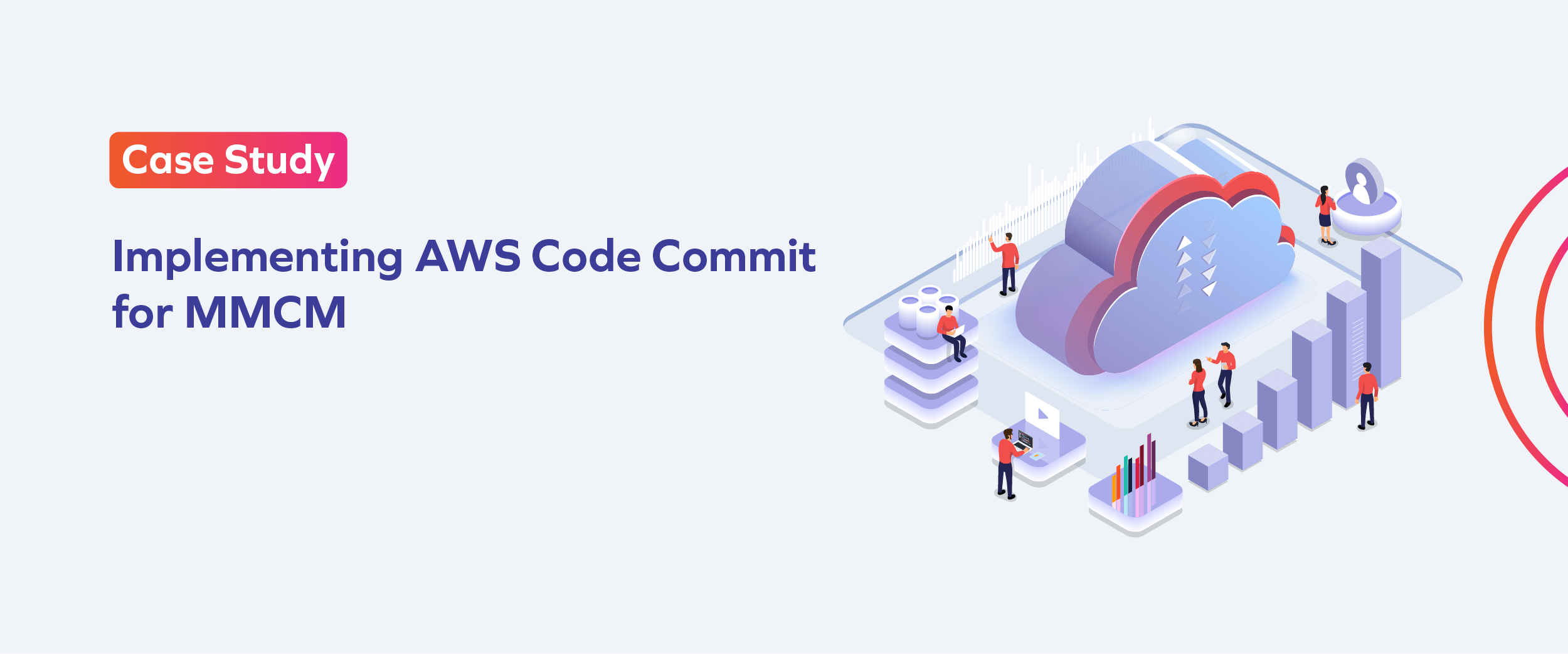
About the Company
Implementation of AWS Code Commit and Code Pipeline for MMCM
- Client: Meta Materials Circular Markets Pvt Ltd (MMCM)
- Services Provided: AWS Integration and Code Management
- Services Used: AWS CodeCommit, AWS Code Pipeline, IAM, MFA, KMS, AWS Cloudtrail
MMCM is an automotive based company. It is an Envirotech enterprise providing all-round solutions for end-of-life vehicles (ELV).
Source control systems are integral to modern DevOps practices. They facilitate version control, enable concurrent development, and maintain a detailed history of all modifications. AWS CodeCommit is a version control service hosted by Amazon Web Services (AWS) that you can use to privately store and manage assets such as documents, source code, and binary files. It is an in-house repository or infrastructure that hold repositories. AWS CodeCommit basically gives you an environment where we can actually go ahead and commit our code, code pushes it or pull it.
To ensure secure collaboration on both frontend and backend files for their “digielv” application, we implemented AWS Code Commit as a source control for their web application.
With AWS CodePipeline, every code commit to CodeCommit triggers an automated build, test, and deployment workflow, ensuring that changes are validated and deployed efficiently. This integration enhances development agility by streamlining the delivery pipeline, reducing manual intervention, and maintaining a consistent and reliable deployment process for MMCM’s application


Challenges
1.Version Control Issues: Difficulty in managing versions of code, leading to potential overwrites and loss of work.
2.Collaboration Barriers: Inefficient collaboration among team members due to lack of a centralized repository.
3.Manual Backup Management: Risk of data loss due to reliance on manual backups and lack of automated versioning.
4.Scalability Concerns: Problems scaling the codebase management as the team and project grow.
5.Security Risks: Inadequate security controls and access management for code repositories.
Optimizing the migration process to minimize downtime and ensure data integrity while transferring large volumes of data (100 GB) securely and efficiently from on-premises servers to AWS.
Configuring and managing a robust network infrastructure to
establish secure and reliable connections between on-premises data centers and AWS infrastructure, ensuring minimal latency and maximum uptime.
Designing and implementing a scalable storage architecture that can seamlessly accommodate the expected growth of data volumes into terabytes, while ensuring high availability and performance
Maintaining high data availability and performance consistency across distributed networks
Objectives
- Secure and Scalable Source Control: MMCM needed a reliable and secure environment for collaborative coding, capable of scaling with their project demands.
- Enhanced DevOps Integration: The MMCM wanted to streamline their continuous integration and continuous deployment (CI/CD) processes by integrating closely with other AWS services.
- Establish a fully automated pipeline to streamline build, test, and deployment processes
- Implement IAM-based access control to restrict direct access to production environments.
- Improved Development Efficiency: The aim was to improve overall code quality and team collaboration through advanced source control features.
- Roll back automatically in case of deployment failures.
Optimizing the migration process to minimize downtime and ensure data integrity while transferring large volumes of data (100 GB) securely and efficiently from on-premises servers to AWS.
Configuring and managing a robust network infrastructure to
establish secure and reliable connections between on-premises data centers and AWS infrastructure, ensuring minimal latency and maximum uptime.
Designing and implementing a scalable storage architecture that can seamlessly accommodate the expected growth of data volumes into terabytes, while ensuring high availability and performance
Maintaining high data availability and performance consistency across distributed networks

Success Metrics
- Enhanced Security Compliance
- Security Incidents: Tracking the frequency and severity of security incidents can indicate improved security measures.
- Example Metric: 50% Reduction in security incidents due to stringent IAM controls and automatic encryption provided by CodeCommit.
- Developer Productivity
- Time to Release: Measures the time from code commit to production deployment.
- Example Metric: 25% improvement in deployment frequency, enabling more frequent updates and quicker feature rollouts.
- System Downtime and Reliability
- Availability: Tracking the uptime of the version control system.
- Example Metric: Achieving 99.99% uptime, compared to 99.95% with GitHub, reflecting higher reliability in AWS’s infrastructure
- Deployment Frequency
- Metric: Increased deployments from weekly to multiple times per day.
- Solution: We utilized AWS CodePipeline to automate the build, test, and deploy processes. Enabled parallel stages for faster delivery and integrate triggers to start the pipeline automatically on code changes.
Optimizing the migration process to minimize downtime and ensure data integrity while transferring large volumes of data (100 GB) securely and efficiently from on-premises servers to AWS.
Configuring and managing a robust network infrastructure to
establish secure and reliable connections between on-premises data centers and AWS infrastructure, ensuring minimal latency and maximum uptime.
Designing and implementing a scalable storage architecture that can seamlessly accommodate the expected growth of data volumes into terabytes, while ensuring high availability and performance
Maintaining high data availability and performance consistency across distributed networks


Results
- Increased Development Efficiency: The transition to AWS CodeCommit reduced the code integration time by 20%, thanks to automated workflows and better collaboration tools.
- Enhanced Security and Compliance: With advanced encryption and detailed access controls, MMCM experienced a significant improvement in their security posture.
How Galaxy Successfully Solved the Company’s Challenges
1.IAM Role Configuration
• Galaxy used AWS Identity and Access Management (IAM) to create granular roles and policies, specifying who could access the CodeCommit repositories and what actions they were authorized to perform. This included:
• Least Privilege Principle: Each role was configured to have the minimum necessary permissions, reducing potential security risks.
• Role-Based Access Control (RBAC): Roles were assigned based on team function, ensuring developers, testers, and admins had appropriate access levels.
2.Encryption at Rest and in Transit
To protect the code from unauthorized access, Galaxy implemented:
•Encryption at Rest: Utilizing AWS Key Management Service (KMS), all data stored in CodeCommit was encrypted using customer-managed keys, providing an additional layer of security and control.
•Encryption in Transit: All data transmitted to and from AWS CodeCommit was encrypted using TLS (Transport Layer Security), safeguarding data as it moved across networks.
•Multi-Factor Authentication (MFA): Galaxy enforced Multi-Factor Authentication for all users accessing the CodeCommit repositories. This practice added an extra verification step to prevent unauthorized access, particularly important when dealing with sensitive or critical project data.
3.Regular Audits and Monitoring
•CloudTrail Integration: AWS CloudTrail was enabled to log all activity in CodeCommit, including detailed information about API calls. This allowed for continuous monitoring and auditing of repository access and changes.
•Real-Time Alerts: Using Amazon CloudWatch and Zabbix , Galaxy set up alerts for any unusual or unauthorized access patterns, such as access at odd hours or rapid changes in repository contents.
1.Reduction in Operational Costs
Cost Savings: Using AWS CodeCommit might reduce costs related to repository management due to AWS’s pricing structure, particularly for private repositories and larger teams.
Example Metric: 30% reduction in monthly costs compared to using GitHub, considering AWS’s pricing tiers and free allowances for certain levels of usage.
2.Enhanced Security Compliance
Security Incidents: Tracking the frequency and severity of security incidents can indicate improved security measures.
Example Metric: 40% reduction in security incidents due to stringent IAM controls and automatic encryption provided by CodeCommit.
3.Developer Productivity
Time to Release: Measures the time from code commit to production deployment.
Example Metric: 25% improvement in deployment frequency, enabling more frequent updates and quicker feature rollouts.
Developer Engagement: Tracking how actively and frequently developers commit changes can indicate higher engagement and productivity.
Example Metric: 15% increase in daily commits per developer, suggesting better tooling and integration ease with AWS CodeCommit.
4.System Downtime and Reliability
Availability: Tracking the uptime of the version control system.
Example Metric: Achieving 99.99% uptime, compared to 99.95% with GitHub, reflecting higher reliability in AWS’s infrastructure.
Incident Response Time: The time taken to resolve issues that arise.
Example Metric: 50% improvement in incident response time due to AWS’s integrated monitoring and alerting tools.
5.Cost Efficiency in Data Transfer and Storage
Data Transfer Costs: Given AWS’s pricing model, transferring data within the AWS ecosystem (e.g., between CodeCommit and EC2 or CodeBuild) might be more cost-effective.
Example Metric: 20% reduction in data transfer costs due to intra-AWS data transfers not incurring external bandwidth fees.

Results
1.Increased Development Efficiency: The transition to AWS CodeCommit reduced the code integration time by 30%, thanks to automated workflows and better collaboration tools.
2.Enhanced Security and Compliance: With advanced encryption and detailed access controls, MMCM experienced a significant improvement in their security posture.
3.Scalability and Reliability: The ability to scale seamlessly with project demands without compromising on performance or availability was a key outcome of implementing CodeCommit.
AWS CodeCommit proved to be a strategic asset for MMCM, aligning with their needs for a secure, scalable, and integrated development environment. The success of this implementation has set a precedent for future projects, positioning MMCM to leverage AWS technologies to their full potential.


